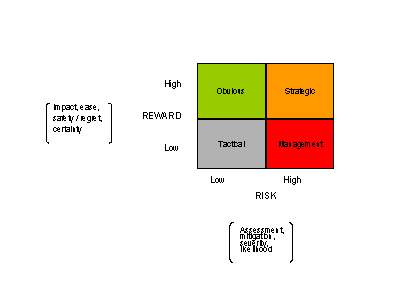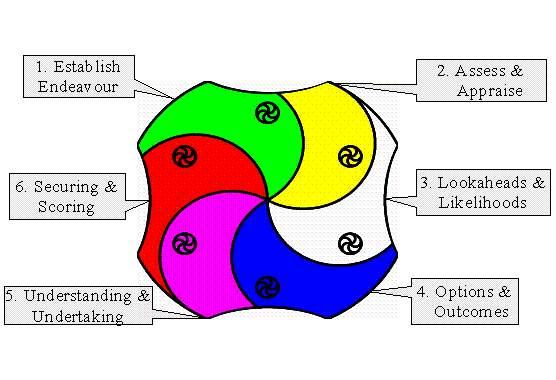For A Good Cause (Working With Not-For-Profit Organisations)
By
Ian Harris and Professor Michael Mainelli
Published by IT Consultant, Penton Technology Media, page 54-57.
Outline risk/reward thinking
At Z/Yen, we describe our discipline as risk/reward management. We believe strategy essentially to be a means of making high-risk, high-reward decisions to maximum effect. Organisations improve by managing risk and enhancing reward more effectively. The following diagram illustrates the point, by setting out four types of decision making using the "old favourite" two by two matrix.

In other words:
- Low risk, low reward decisions tend to be tactical;
- High risk, low reward decisions tend to be management matters (e.g. risk management);
- Low risk, high reward decisions tend to be obvious (just **** do it);
- High risk, high reward decisions tend to be strategic.
Z/Yen's six stage strategic approach, Z/Ealous, helps with those tricky strategic decisions. The following diagram illustrates this approach.

This six stage approach works as follows:
- establish endeavour - define the purpose of the piece of strategic work (mission, goals, values, beliefs);
- assess and appraise - use a variety of strategic planning tools to identify risk/reward issues faced;
- lookaheads and likelihoods - evaluate the severity and likelihood of risks, the benefits and likelihood of rewards, considering several scenarios and options
- options and outcomes - choose appropriate options and validate the decision making;
- understanding and undertaking - clarify who will implement the solution and ensure that the decisions are sufficiently accepted and understood within the organisation;
- securing and scoring - continue the process of contribution, consensus, commitment and communication throughout the piece of work, evaluate and review the work.
Applying risk/reward thinking to IT Consulting in the Not-for-Profit Sector
The process of undertaking IT strategy is not really different from undertaking organisational strategy. However, it is important that IT strategy is aligned with organisational strategy. If the organisational strategy has recently been reviewed and is clearly documented, that strategy document is a good starting point for IT strategy. Often, however, it isn't quite as easy as that and you develop the IT strategy to align with an emerging or sometimes unclear organisational strategy. We advocate organisations reviewing their IT strategy whenever the organisations strategy is reviewed. However, IT strategies date mighty fast these days, so the IT strategy should be reviewed every two to three years even if the organisational strategic cycle is longer.
Undertaking strategic IT work in not-for-profit organisations is only a little different from applying our "slightly scientific art" in other sectors. The following paragraphs highlight the few areas where we believe there is a difference.
Not-for-profit organisational cultures tend to favour consultative, collaborative techniques. Apart from the cultural reason, there is a practical reason for this, as they also have unusually diverse staff and stakeholders. As a result, at Z/Yen we tend to place emphasis on focus groups, surveys etc. as part of consultation in the not-for-profit sector.
Not-for-profit organisations tend to have especially high aspirations and especially low budgets. Leaders in not-for-profit organisations tend to be visionary, aspirational, audacious and bold. However the regulatory regime of not-for-profit organisations (based on the law of trusts with additional regulation for charities) ensures that the trustees are risk-averse. Managers in not-for-profit organisations are often culturally risk-averse people. Finally, the available resources and budgets are usually highly constrained regardless of your flavour for risk.
For the above reason, at Z/Yen we place special focus on helping our clients in setting achievable objectives in IT strategies, prioritisation of possible projects and finding "good enough" solutions. This approach helps the resource-strapped to achieve most of their IT aims with modest investment.
In any organisation IT projects need demonstrable benefits to pass the IT governance test. However, in not-for-profit organisations the benefits are often non-financial and hard to measure. Some people argue that if it's hard to measure you shouldn't bother. We tend to argue the converse, if it's hard to measure the benefits then try harder, but measure you must. Similarly, not-for-profit organisations need to demonstrate the value of their work to stakeholders and to the public. We often find that the tough benefits measures we try to apply to the governance of IT are often closely linked with measures that enable the organisation to provide evidence of its worth. The two examples below give a short illustration of these points.
Examples of using IT to supply evidence of worth
The Children's Society MART (With thanks to Nigel Hinks of the Children’s Society for his contribution towards this section)
The Children's Society (The Society) is committed to tackling the root causes of problems faced by children and young people, especially those whose circumstances make them particularly vulnerable. It has an annual income of c£40M, runs about 100 social work projects and employs c1200 staff.
The Social Work Performance Measurement and Recording Initiative (MART Initiative) was designed to equip social work projects and units with the knowledge and ability to undertake performance measurement and recording in a harmonised way. The benefits sought from MART include encouraging good practice, improving the quality of information, evaluating the effectiveness of practice and providing the ability to measure and learn from information shared between groups of project and units.
The IT structure required for this initiative was very straightforward. The Society already had established PCs in each project with Microsoft Office (including Microsoft Access) available, together with modem links into a remote access e-mail service through headquarters. In a few larger projects, the Society has needed to implement small peer-to-peer networks to enable project workers to use MART efficiently and effectively. In the most part, this initiative "piggy-backed" on existing IT infrastructure.
The tools designed to support the Initiative are:
- MART: the Measurement and Recording Template, which has been developed by the Society's IT department specifically to support this work. MART is a configurable Microsoft Access database, which provides a common data structure while enabling projects/units to meet local information needs safely, securely & flexibly;
- SMART: Several "MARTs", allowing data from several MART sites to be consolidated for reporting, comparison and shared learning.
The IT development was a fairly low-key matter, with one Society Access expert working part time on the initiative for eighteen months or so, under the supervision of Z/Yen. In the later stages, other Society staff were involved in the testing and brainstorming on improvements to the tool. The emphasis from the outset was on skills transfer to ensure that the Society would be self-sufficient once the initiative was implemented.
The rollout to over 120 projects and units is taking place between 2000 and 2002. All but 20 or so projects and units have started work on MART at the time of writing (Autumn 2001). The Society is already using knowledge obtained through this Initiative on other Society Initiatives such as planning and project management of IT projects, information models used for liaison between departments and MART potentially being used as a tool in other Society departments.
The Marine Stewardship Council - Alaskan Salmon Model
The Marine Stewardship Council (MSC)'s objectives are to bring about a sea change in oceans management by providing economic incentives for sustainable behaviour and advancing public education in the principles and practice of conservation. The MSC is now one of the leading voices in the marine conservation community. It is a global charitable organisation with its international headquarters in London.
The MSC has a refreshingly business-like approach to providing evidence of its worth. Brendan May, the MSC Chief Executive, says "business people are used to undertaking cost/benefit analysis to support their decisions and often feel uneasy when not-for-profit organisations advocate solely intangible or qualitative benefits. Of course, some not-for-profit issues are intrinsically qualitative, hard to measure and tricky to express in financial value terms. Our argument is that not-for-profits should nevertheless try their best to provide empirical evidence to back requests to the business world. This sometimes requires real imagination".
For example, Z/Yen has been working with the MSC to try and prove the tangible value of the MSC's certification scheme for sustainable fishing using the same risk/reward option theory techniques that Z/Yen uses to help industry with decision making and government lobbying. The IT required to do this work is very straightforward. Using historical data on fish volumes and prices in Excel spreadsheets, with some use of Crystal Ball for predictive modeling, has enabled us to model the Alaskan Salmon industry (five major species of salmon). Using this model, we can value the reduced market volatility that following the MSC standard should yield (using option pricing theory) and thus evaluate and measure the scheme's worth. If our conservative assumptions are correct, the implied saving to the Alaskan Salmon industry is over $1M a year, some 50 times more than the cost of the certification ($100,000 for five years). After a few years, the predictions will be replaced with actual data on post-certification volatility. We hope that the savings will be even greater than estimated.
This is an example of using simple IT to do sophisticated things, rather than the sophisticated use of IT which tends to bog down IT projects in not-for-profit organisations. Many not-for-profit organisations can use these and similar techniques to support development, fundraising, service provision and campaigning work.
Summary
IT consulting is a similar discipline in the not-for-profit sector, but you need to work smart as well as hard to help organisations to get more bang for their buck. Demonstrating the benefits of IT and using IT to help the organisation to provide evidence of worth are key issues for the sector. It's hard work and not as financially rewarding as doing similarly excellent work for commercial organisations. But it is rewarding in other ways; doing IT for the not-for-profit sector is enormously challenging and satisfying.
Ian Harris and Michael Mainelli are Directors of Z/Yen Limited, the risk/reward management practice. Their most recent book, IT for the Not-for-Profit Sector, is published by ICSA Publishing, ISBN 1860721303.
Z/Yen Limited specialises in risk/reward management, an innovative approach to improving performance through strategy, systems, people and organisation. Z/Yen clients include blue chip companies in banking, insurance, distribution and sales/service companies as well as many not-for-profit organisations.
[A version of this article originally appeared as "For a Good Cause" (working with not-for-profit organisations, IT Consultant, (November 2001) pages 54-57.]